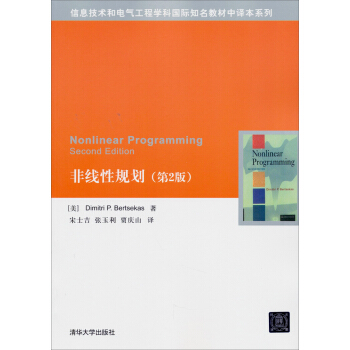

具体描述
内容简介
The relationships (both conceptual and mathematical) between Bayesian analysis and statistical decision theory are so strong that it is somewhat unnatural to learn one without the other. Nevertheless, major portions of each have developed separately. On the Bayesian side, there is an extensively developed Bayesian theory of statistical inference (both subjective and objective versions). This theory recognizes the importance of viewing statistical analysis conditionally (i.e., treating observed data as known rather than unknown), even when no loss function is to be incorporated into the analysis. There is also a well-developed (frequentist) decision theory, which avoids formal utilization of prior distributions and seeks to provide a foundation for frequentist statistical theory. Although the central thread of the book will be Bayesian decision theory, both Bayesian inference and non-Bayesian decision theory will be extensively discussed. Indeed, the book is written so as to allow, say, the teaching of a course on either subject separately.目录
CHAPTER 1Basic Concepts
1.1 Introduction
1.2 Basic Elements
1.3 Expected Loss, Decision Rules, and Risk
1.3.1 Bayesian Expected Loss
1.3.2 Frequentist Risk
1.4 Randomized Decision Rules
1.5 Decision Principles
1.5.1 The Conditional Bayes Decision Principle
1.5.2 Frequentist Decision Principles
1.6 Foundations
1.6.1 Misuse of Classical Inference Procedures
1.6.2 The Frequentist Perspective
1.6.3 The Conditional Perspective
1.6.4 The Likelihood Principle
1.6.5 Choosing a Paradigm or Decision Principle
1.7 Sufficient Statistics
1.8 Convexity
Exercises
CHAPTER 2 Utility and Loss
2.1 Introduction
2.2 Utility Theory
2.3 The Utility of Money
2.4 The Loss Function
2.4.1 Development from Utility Theory
2.4.2 Certain Standard Loss Functions
2.4.3 For Inference Problems
2.4.4 For Predictive Problems
2.4.5 Vector Valued Loss Functions
2.5 Criticisms
Exercises
CHAPTER 3 Prior Information and Subjective Probability
3.1 Subjective Probability
3.2 Subjective Determination of the Prior Density
3.3 Noninformative Priors
3.3.1 Introduction
3.3.2 Noninformative Priors for Location and Scale Problems
3.3.3 Noninformative Priors in General Settings
3.3.4 Discussion
3.4 Maximum Entropy Priors
3.5 Using the Marginal Distribution to Determine the Prior
3.5.1 The Marginal Distribution
3.5.2 Information About tn
3.5.3 Restricted Classes of Priors
3.5.4 The ML-II Approach to Prior Selection
3.5.5 The Moment Approach to Prior Selection
3.5.6 The Distance Approach to Prior Selection
3.5.7 Marginal Exchangeability
3.6 Hierarchical Priors
3.7 Criticisms
3.8 The Statisticians Role
Exercises
CHAPTER 4 Bayesian Analysis
4.1 Introduction
4.2 The Posterior Distribution
4.2.1 Definition and Determination
4.2.2 Conjugate Families
4.2.3 Improper Priors
4.3 Bayesian Inference
4.3.1 Estimation
4.3.2 Credible Sets
4.3.3 Hypothesis Testing
4.3.4 Predictive Inference
4.4 Bayesian Decision Theory
4.4.1 Posterior Decision Analysis
4.4.2 Estimation
4.4.3 Finite Action Problems and Hypothesis Testing
4.4.4 With Inference Losses
4.5 Empirical Bayes Analysis
4.5.1 Introduction
4.5.2 PEB For Normal Means--The Exchangeable Case
4.5.3 PEB For Normal Means--The General Case
4.5.4 Nonparametric Empirical Bayes Analysis
4.6 Hierarchical Bayes Analysis
4.6.1 Introduction
4.6.2 For Normal Means--The Exchangeable Case
4.6.3 For Normal Means--The General Case
4.6.4 Comparison with Empirical Bayes Analysis
4.7 Bayesian Robustness
4.7.1 Introduction
4.7.2 The Role of the Marginal Distribution
4.7.3 Posterior Robustness: Basic Concepts
4.7.4 Posterior Robustness: s-Contamination Class
4.7.5 Bayes Risk Robustness and Use of Frequentist Measures
4.7.6 Gamma-Minimax Approach
4.7.7 Uses of the Risk Function
4.7.8 Some Robust and Nonrobust Situations
4.7.9 Robust Priors
4.7.10 Robust Priors for Normal Means
4.7.11 Other Issues in Robustness
4.8 Admissibility of Bayes Rules and Long Run Evaluations
4.8.1 Admissibility of Bayes Rules
4.8.2 Admissibility of Generalized Bayes Rules
4.8.3 Inadmissibility and Long Run Evaluations
4.9 Bayesian Calculation
4.9.1 Numerical Integration
4.9.2 Monte Carlo Integration
4.9.3 Analytic Approximations
4.10 Bayesian Communication
4.10.1 Introduction
4.10.2 An Illustration: Testing a Point Null Hypothesis
4.11 Combining Evidence and Group Decisions
4.11.1 Combining Probabilistic Evidence
4.11.2 Combining Decision-Theoretic Evidence
4.11.3 Group Decision Making
4.12 Criticisms
4.12.1 Non-Bayesian Criticisms
4.12.2 Foundational Criticisms
Exercises
CHAPTER 5 Minimax Analysis
5.1 Introduction
5.2 Game Theory
5.2.1 Basic Elements
5.2.2 General Techniques for Solving Games
5.2.3 Finite Games
5.2.4 Games with Finite
5.2.5 The Supporting and Separating Hyperplane Theorems
5.2.6 The Minimax Theorem
5.3 Statistical Games
5.3.1 Introduction
5.3.2 General Techniques for Solving Statistical Games
5.3.3 Statistical Games with Finite
5.4 Classes of Minimax Estimators
5.4.1 Introduction
5.4.2 The Unbiased Estimator of Risk
5.4.3 Minimax Estimators of a Normal Mean Vector
5.4.4 Minimax Estimators of Poisson Means
5.5 Evaluation of the Minimax Principle
5.5.1 Admissibility of Minimax Rules
5.5.2 Rationality and the Minimax Principle
5.5.3 Comparison with the Bayesian Approach
5.5.4 The Desire to Act Conservatively
5.5.5 Minimax Regret
5.5.6 Conclusions
Exercises
CHAPTER 6 Invariance
6.1 Introduction
6.2 Formulation
6.2.1 Groups of Transformations
6.2.2 Invariant Decision Problems
6.2.3 Invariant Decision Rules
6.3 Location Parameter Problems
6.4 Other Examples of Invariance
6.5 Maximal lnvariants
6.6 Invariance and Noninformative Priors
6.6.1 Right and Left Invariant Haar Densities
6.6.2 The Best Invariant Rule
6.6.3 Confidence and Credible Sets
6.7 Invariance and Minimaxity
6.8 Admissibility of Invariant Rules
6.9 Conclusions
Exercises
CHAPTER 7 Preposterior and Sequential Analysis
7.1 Introduction
7.2 Optimal Fixed Sample Size
7.3 Sequential Analysis--Notation
7.4 Bayesian Sequential Analysis
7.4.1 Introduction
7.4.2 Notation
7.4.3 The Bayes Decision Rule
7.4.4 Constant Posterior Bayes Risk
7.4.5 The Bayes Truncated Procedure
7.4.6 Look Ahead Procedures
7.4.7 Inner Truncation
7.4.8 Approximating the Bayes Procedure and the Bayes Risk
7.4.9 Theoretical Results
7.4.10 Other Techniques for Finding a Bayes Procedure
7.5 The Sequential Probability Ratio Test
7.5.1 The SPRT as a Bayes Procedure
7.5.2 Approximating the Power Function and the Expected Sample Size
7.5.3 Accuracy of the Wald Approximations
7.5.4 Bayes Risk and Admissibility
7.5.5 Other Uses of the SPRT
7.6 Minimax Sequential Procedures
7.7 The Evidential Relevance of the Stopping Rule
7.7.1 Introduction
7.7.2 The Stopping Rule Principle
7.7.3 Practical Implications
7.7.4 Criticisms of the Stopping Rule Principle
7.7.5 Informative Stopping Rules
7.8 Discussion of Sequential Loss Functions
Exercises
CHAPTER 8 Complete and Essentially Complete Classes
8.1 Preliminaries
8.2 Complete and Essentially Complete Classes from Earlier Chapters
8.2.1 Decision Rules Based on a Sufficient Statistic
8.2.2 Nonrandomized Decision Rules
8.2.3 Finite O
8.2.4 The Neyman-Pearson Lemma
8.3 One-Sided Testing
8.4 Monotone Decision Problems
8.4.1 Monotone Multiple Decision Problems
8.4.2 Monotone Estimation Problems
8.5 Limits of Bayes Rules
8.6 Other Complete and Essentially Complete Classes of Tests
8.6.1 Two-Sided Testing
8.6.2 Higher Dimensional Results
8.6.3 Sequential Testing
8.7 Complete and Essentially Complete Classes in Estimation
8.7.1 Generalized Bayes Estimators
8.7.2 Identifying Generalized Bayes Estimators
8.8 Continuous Risk Functions
8.9 Proving Admissibility and Inadmissibility
8.9.1 Steins Necessary and Sufficient Condition for Admissibility
8.9.2 Proving Admissibility
8.9.3 Proving Inadmissibility
8.9.4 Minimal or Nearly Minimal Complete Classes
Exercises
APPENDIX 1 Common Statistical Densities
I Continuous
II Discrete
APPENDIX 2 Supplement to Chapter 4
I Definition and Properties of Hm
II Development of (4.121) and (4.122)
III Verification of Formula (4.123)
APPENDIX 3 Technical Arguments from Chapter 7
I Verification of Formula (7.8)
II Verification of Formula (7.10)
Bibliography
Notation and Abbreviations
Author Index
Subject Index
前言/序言
用户评价
初次接触这本书,我最直观的感受是其内容的“硬核”。它毫不避讳地深入探讨了统计决策理论的核心概念,比如损失函数、效用函数、风险函数等,这些都是构建决策模型的基础。作者的写作风格非常务实,强调的是如何将这些理论应用于实际问题。在我看来,这本书最出彩的地方在于它对贝叶斯分析的讲解。不同于许多教科书仅仅罗列公式,本书详细阐述了贝叶斯定理的直观意义,以及如何通过似然函数和先验分布来更新后验分布,从而做出更优的决策。特别是对于一些经典的贝叶斯模型,如线性回归中的贝叶斯方法,或是分类问题中的贝叶斯判别分析,书中都给出了详尽的推导和实例演示。我发现,通过这本书的学习,我不仅掌握了理论知识,更重要的是,我学会了如何将这些理论转化为解决实际问题的工具。它教会了我如何根据问题的特性选择合适的模型,如何理解模型的假设,以及如何评估模型的优劣。这本书对于任何希望在量化决策和数据驱动分析领域深入研究的读者来说,都是一份宝贵的财富。
评分这本书就像是一位循循善诱的导师,引导我一步步穿越统计决策理论的迷宫。我特别喜欢作者对于“无知”的处理方式,在信息不完全或者不确定性很高的情况下,如何通过引入先验分布来弥合知识的鸿沟。书中关于“信息价值”的讨论也让我受益匪浅,它让我们思考,为了获得某个决策所需的额外信息,我们愿意付出多少代价,以及如何设计有效的实验来获取这些信息。在贝叶斯分析的部分,作者巧妙地将复杂的概率推理过程分解为易于理解的步骤,让我能够清晰地把握每一步的逻辑。例如,在处理序列数据时,书中对马尔可夫链的介绍,以及如何利用它来构建预测模型,都给我留下了深刻的印象。读完这本书,我感觉自己不仅是在学习一门学科,更是在培养一种看待问题的方式——一种更加审慎、更加数据导向、也更加能够拥抱不确定性的思维模式。它让我明白,在信息不完整的世界里,我们并非束手无策,而是可以通过科学的方法来做出更好的决策。
评分这本书的阅读体验是充满挑战与惊喜的结合。在深入研究统计决策理论的某些章节时,我曾感到过一丝迷茫,特别是当面对一些复杂的优化问题时。然而,正是这种挑战,促使我去更深入地思考和理解。书中对不同类型损失函数的讨论,以及它们如何影响决策结果,是我之前很少深入接触的。而贝叶斯分析的部分,则是我感到惊喜连连的地方。作者在解释贝叶斯定理的演进过程时,用非常形象的比喻,让我能够直观地理解“先验”和“后验”的概念。特别是在处理“模型选择”这一关键问题时,书中提供了多种贝叶斯视角下的方法,如模型平均等,这为我打开了新的思路。我发现,这本书不仅仅是提供知识,更重要的是教会我如何思考,如何从不同的角度审视问题。即使是对于一些看似简单的决策,这本书也能引导我去挖掘其背后更深层次的统计原理。它是一本需要投入时间和精力去研读的书,但每一次的深入,都会带来意想不到的收获。
评分这本书的书名让我一度望而却步,"统计决策理论"听起来就充满了数学和逻辑的严谨,而"贝叶斯分析"更是让人联想到复杂的概率模型和迭代计算。然而,一旦翻开,我便被其深度和广度所吸引。作者并没有止步于理论的陈述,而是通过大量精心设计的案例,将抽象的概念具象化。从最初的简单决策问题,到后面涉及多阶段决策、不确定性下的策略选择,每一个章节都像是在搭建一座精密的模型,引导读者一步步深入理解如何量化风险,如何权衡收益。我尤其欣赏其中关于先验信息的处理方式,它不仅仅是数学公式的堆砌,更是对决策者主观判断和客观数据的巧妙融合,让人体会到贝叶斯方法在信息更新和信念调整上的强大力量。即使是对于一些我之前认为非常棘手的概念,例如马尔可夫决策过程,书中也提供了清晰的解释和直观的类比,让我在阅读过程中感受到思维的豁然开朗。这本书的价值远不止于理论学习,它更像是一把钥匙,开启了我用更系统、更理性的方式去审视和解决现实世界中复杂问题的视野。
评分我之所以对这本书情有独钟,是因为它在理论的深度和应用的广度之间找到了完美的平衡点。在统计决策理论方面,本书系统地梳理了从基础概念到高级模型的演进脉络,让我能够清晰地认识到不同决策框架的优势与局限。特别是在处理现实世界中的复杂决策时,书中提供的多种工具和方法,如动态规划、博弈论等,都具有极强的实践指导意义。而贝叶斯分析的章节,更是让我体会到了其在数据挖掘和机器学习领域的强大威力。书中对贝叶斯网络的讲解,以及如何利用它进行因果推断和预测,是我之前学习中从未见过如此清晰和系统的阐述。我发现,这本书不仅仅是知识的罗列,更重要的是它能够激发读者的思考,鼓励读者去探索和创新。每一次阅读,我都能从中获得新的启发,不断刷新我对统计决策和贝叶斯分析的理解。这本书无疑是我学习道路上的一座重要里程碑。
评分挺理论的书 不过springer的书都很理论 德国人嘛
评分经典图书,值得推荐购买
评分正是我需要的。
评分次系列影印版的书虽然字迹印刷的不是非常清晰,但相对与原版来说性价比非常高。统计决策和贝叶斯方向非常专业的资料。
评分Peter Norvig / Stuart Russell《人工智能:一种现代方法》
评分都挺好的,包装精美,只是赶上双十一,送货慢了一些。
评分Bayesian network technologies(贝叶斯网络技术:应用与图形模型)
评分专业书籍,需要的时候查阅用的。
评分好喜欢呀。买来看看呢
相关图书
本站所有内容均为互联网搜索引擎提供的公开搜索信息,本站不存储任何数据与内容,任何内容与数据均与本站无关,如有需要请联系相关搜索引擎包括但不限于百度,google,bing,sogou 等,本站所有链接都为正版商品购买链接。
© 2026 windowsfront.com All Rights Reserved. 静流书站 版权所有









![高等量子力学 [Advanced Quantum Mechanics] pdf epub mobi 电子书 下载](https://pic.windowsfront.com/10096466/c12ae560-d351-419d-8f1e-35ed17efa5e6.jpg)


![流形拓扑导论讲义(英文版) [Introductory Lectures on Manifold Topology:Signposts] pdf epub mobi 电子书 下载](https://pic.windowsfront.com/11434975/565d1577N756cb831.jpg)

![环境空气PM2.5监测、预报与公众信息服务 [Ambient PM2.5 MOnitoring,Forecasting, and Public Information Service] pdf epub mobi 电子书 下载](https://pic.windowsfront.com/11898830/57079e18N9199f7f7.jpg)




![第二代测序信息处理 [Next-generation DNA sequencing informatics] pdf epub mobi 电子书 下载](https://pic.windowsfront.com/11678643/554205ccN857d36a2.jpg)
